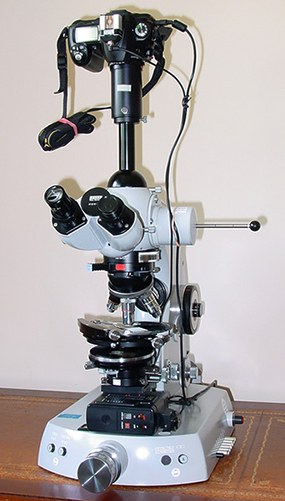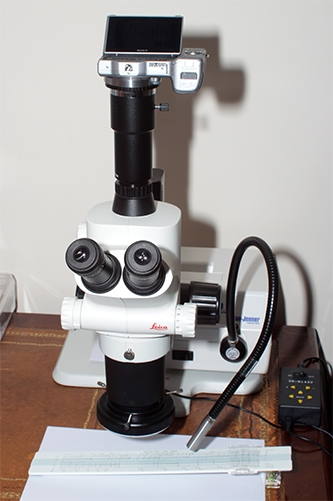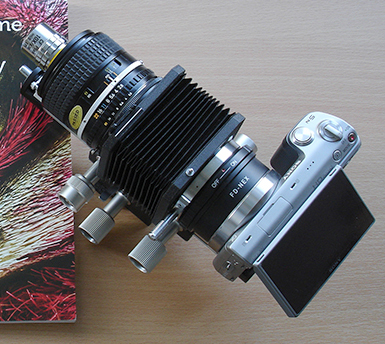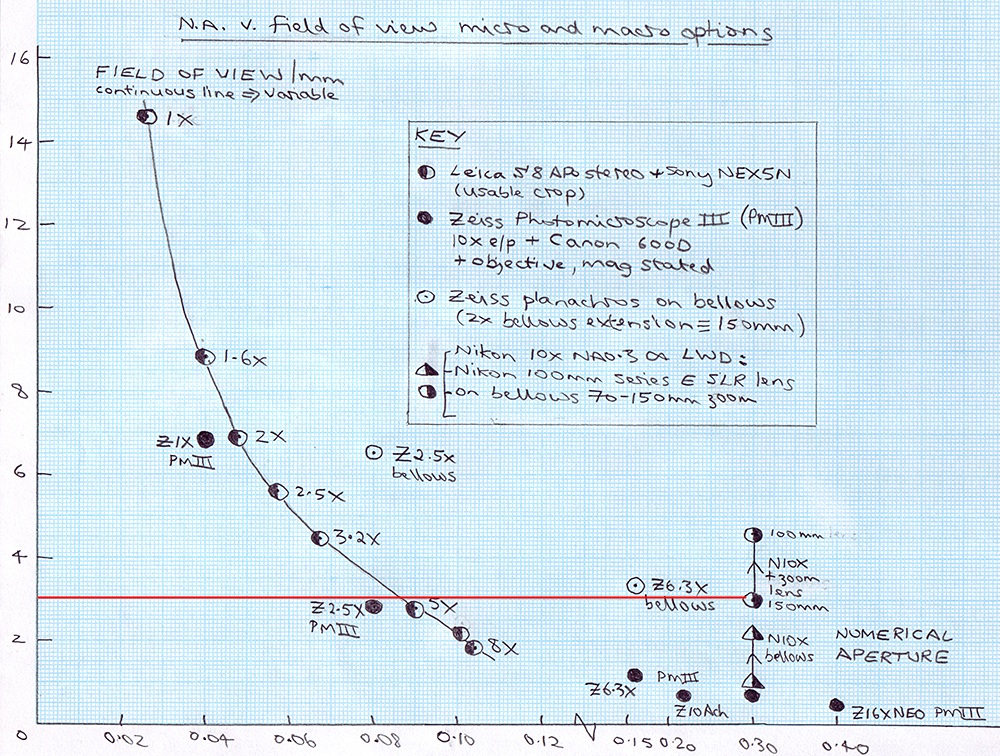

Topical Tip: The value of a numerical aperture v field of view graph for macro / micro setups owned.
by David Walker, UK
Many enthusiasts, myself included, can build up a variety of setups that are capable of low power microscopy through to macro. Three of my own with digital imaging capabilities are shown below. The range of subject sizes that each can capture often overlap to a greater or lesser extent. I find it handy to plot a graph of each setup's field of view against their numerical apertures. This allows a quick visual assessment of which setup to use for a given subject size; the final choice depending on a number of factors which are summarised below.


Left: Zeiss Photomicroscope III with DSLR. This is an earlier setup, the present setup uses the sturdier Zeiss vertical phototube and the DSLR is now a Canon 600D. The projection eyepiece is a Zeiss 10X Kpl-W raised a few mm to form a real image. Distortion
control is excellent within an APS sensor field.
Right: Leica S8 APO 1-8X zoom stereo. A Sony NEX-5N body (APS sensor) makes use of the lensless 1X photo-port which gives some vignetting. With modern multipixel digicams I regard modest vignetting as useful; if capture the full visual field circle can crop image to suit.
Both the Canon and Sony cameras have electronic first curtain shutters to reduce vibration on exposure to a minimum.

Left: Canon FD manual bellows with Sony NEX-5N body and a Nikon CF plan 10/0.30 LWD infinity objective. The relay
lens is a Nikon 100 mm f2.8 Series E telephoto.
An alternative setup (not shown) uses the Nikon objective on a Nikon 70 - 150 mm f4.5 Series E telephoto.
A parameter I have dispensed with long ago for assessing low power micro / macro setups and suspect others have is magnification. With such a variety of sensor sizes and final image sizes (on screen or print with often 40X or greater sensor to screen mags adding to the total mag), mags as a useful practical parameter is arguably limited. Field of view can be of far more value (and to declare on the final image as horizontal field width). When choosing a setup to use an owner will also have an idea from the start how large the subject field will be.
The FOV v NA plot is useful as NA defines the ultimate resolution of the system and hence the final image detail. No matter if stitching or stacking is introduced to extend field in a plane or depth of field, it cannot circumvent the NA and thus the ability to capture fine detail of a given objective. A graph for my main low power setups are shown below.
General remarks:
Stereo microscope: These have the benefit of a wide mag and associated range of field of views but the NAs drop with mag for zoom optics—even for this Leica S8 APO high performance model. Spending five figure sums on a stereo or macroscope won't dramatically improve this performance as the low NAs are a result of the large working distances that stereos / macroscopes typically offer. Greenough microscopes typically use one visual eyepiece
so more planar objects will require a subject support angled at ca. six degrees to vertical to prevent distortion and out of focus planes for imagery.
Compound microscope: All the benefits that a modular model may offer and of course the highest NAs and resolution as move from low to medium and higher powers. The lower powers can be useful for macro but will have low d.o.f and field of view requiring stitching and/or stacking. The objectives' low working distances may hinder any complex incident lighting off-axis.
Finite tube length objectives on bellows or infinity objectives with relay lens: These sort of setups have become very popular as stacking protocols whether manual or automatic become well established. A variety of long working distance objectives with high NA are available and with all corrections made in the objective. The often stunning imagery shared by masters of the technique e.g. of insect heads is reflected in the objectives' very high NAs compared with a stereo or the lowest power compound microscope objectives. For objectives requiring compensating eyepieces for full aberration correction, each needs to be assessed to see if their performance is acceptable when used without an eyepiece.
Which setup to choose: Factors that could be important include.
- image use, modest web page imagery, or highest quality results for display or competitions etc.
- subject type, does it have fine detail that requires high resolution optics, e.g. wing scales, insect head detail or more gross detail such as a whole beetle leg.
- depth of field of subject, is it wholly planar such as an integrated circuit chip or considerable depth such as a flower head.
- subject size, if no stitching planned which setup will capture the field required.
- convenience, which setup is best suited all things considered. I have some setups ready to use on my cramped desk such as the Leica stereo and the Zeiss PMIII. Any bellows type work requires clearing an area and setting up plus suitable lighting.
An example using the graph. Supposing I wished to capture an image of a whole insect ca. 3 mm wide. A red line shows the field of view for this value. Reading across horizontally provides a number of options:
Zeiss planachro 2.5/0.08 on Photomicroscope. Working distance modest at 8.7 mm if require off-axis top lighting. Depth of field will be small requiring stacking but the coarse / fine focus can be put to good use. Image capture uses a vertical optical axis unlike the Greenough stereo.
Leica S8 stereo at ca. 5X objective mag. Slightly better NA at this mag than the Zeiss objective. Better intrinsic depth of field, if stacking needed the focus on my stereo stand not good enough. Excellent working distance for top lighting. For transparent specimens, transmitted light on stereos often basic and not to same quality and control cf. the Photomicroscope. For me the stereo despite its low NAs is often the most convenient setup for modest sized images for subjects with gross detail such as for the Web.
Zeiss planachro 6.3X/0.16 on bellows. I haven't fully checked out this system to date, initial impressions are that aberration could be a concern as no compensating eyepiece. If suitable the NA is nearly twice that of the stereo. Stacking likely needed. Working distance at 4.9 mm becoming small for good incident lighting.
Nikon infinity CF plan epi 10/0.30 LWD with relay lens. By far the best NA optics for this field of view from the options on offer; its resolution is over three times that of the apo stereo at 5X mag. Working distance of 16.5 mm three times that of the Zeiss 6.3X objective. The system of choice for the highest detail capture but for subjects with any depth extensive stacking likely needed. The Canon bellows I use does not have very fine control of the focus for stacking but have used the base of the stripped down Photomicroscope to make use its focussing
and also lighting in transmitted light study.
As an aside, one objective I dislike with a passion is the Zeiss 1/0.04. With its low working distance of 4.7 mm i.e. much less than the 2.5X and its extra length, it is an awkward optic to use on a turret with others. Not helped that my formerly pristine example has now been extensively afflicted by the 'Zeiss curse' - delamination! As the graph shows, the Leica at 2X can offer a similar f.o.v, better NA and far better working distance.

The NAs of the Leica stereo at various mags was determined by the method reported by Gérard Weiss and described in an earlier Micscape article with links to primary sources. The NAs determined match almost exactly those on the optical data sheet for the S8 APO provided by Leica.
Commentsto the author are welcomed.
Published in the April 2019 edition of Micscape.
Please report any Web problems or offer general comments to the Micscape Editor .
Micscape is the on-line monthly magazine of the Microscopy UK web site at Microscopy-UK
©
Onview.net Ltd, Microscopy-UK, and all contributors 1995
onwards. All rights reserved.
Main site is at
www.microscopy-uk.org.uk.